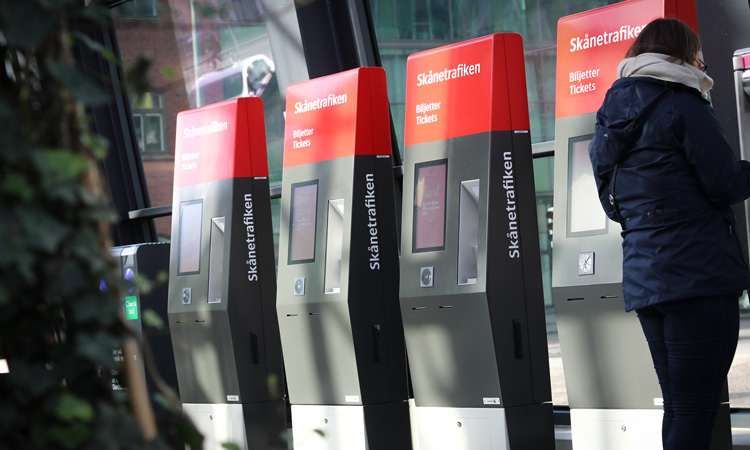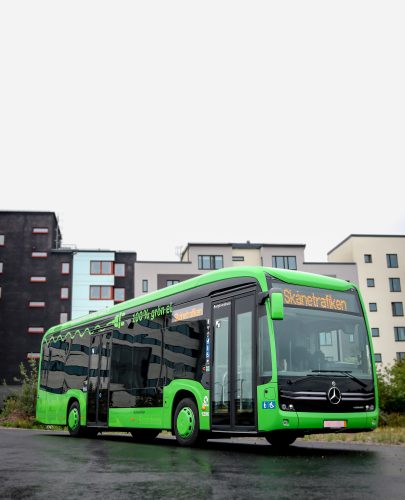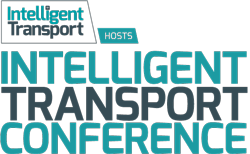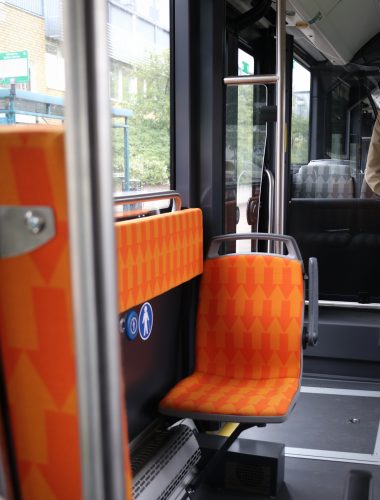The balancing act of delivering modern, reliable and sustainable public transport
- Like
- Digg
- Del
- Tumblr
- VKontakte
- Buffer
- Love This
- Odnoklassniki
- Meneame
- Blogger
- Amazon
- Yahoo Mail
- Gmail
- AOL
- Newsvine
- HackerNews
- Evernote
- MySpace
- Mail.ru
- Viadeo
- Line
- Comments
- Yummly
- SMS
- Viber
- Telegram
- Subscribe
- Skype
- Facebook Messenger
- Kakao
- LiveJournal
- Yammer
- Edgar
- Fintel
- Mix
- Instapaper
- Copy Link
Posted: 21 November 2019 | Carl Bjorklund - Skånetrafiken | No comments yet
Many would agree that delivering successful and reliable public transport is something of a juggling act. Carl Bjorklund from Skånetrafiken spoke to Intelligent Transport’s Luke Antoniou about the authority’s approach to balancing the needs of different passengers, in different communities, in an integrated system that works for all.


New ticket machines. Photo: Jacob Pihl, Skånetrafiken
Could you tell us what you are working on at the moment, what your organisation’s top priority is? Are there any challenges you have encountered along the way?
A minimum frequency or coverage of public transport services, especially in rural areas, is naturally expected. The programme regulates expectations in terms of frequency and timetables in the main corridors, like opening hours and so on. Those elements are quite straightforward and we’re already meeting those expectations on many corridors today. What’s more complicated is targets set regarding market share, by which we mean the modal share of motorised transport. The target is for 40 per cent of all motorised journeys in our region to be made using public transport by 2030 – that’s across the entire region, which inevitably means it will be harder to achieve in rural areas.
The target is for 40 per cent of all motorised journeys in our region to be made using public transport by 2030″
Naturally, urban areas are going to make up a high share of this target. This is for several reasons, the city setting for one thing, but also for environmental reasons. Our region has set bold goals when it comes to climate, pollution and our carbon footprint. Ultimately, we’re aiming to become carbon neutral. This won’t be achievable by 2030, but we are already setting targets when it comes to reducing the footprint, and naturally, public transport is a vital part of that.


Mercedes e-bus. Photo: Jacob Pihl, Skånetrafiken
We have known for some time now that it’s not enough to tell consumers that using public transport is better for the environment than driving their own car. The car industry is developing and there are already many electric cars on the market being advertised to consumers as a green solution. It would be naïve to imply that switching to an electric car will solve the problem, but equally, we realise that we cannot market public transport by simply saying that it’s better to travel together. We need to be as environmentally friendly and sustainable as possible.
We need to be as environmentally friendly and sustainable as possible”
That’s our USP as a public transport provider in our region; we’ve been completely fossil fuel free since 2018. We run solely on biogas and also have a fleet of electric buses, which are only charged with sustainable, green electricity which comes from renewable sources. We plan to increase the number of electric buses further, which forms one part of our strategy for the future; in urban areas and cities, electric buses will be the only buses used in public transport operations.
When it comes to the regional transportation, we already have trains running on electricity from sustainable sources, but we also provide a lot of bus services in rural areas. For the next five to 10 years at least, biogas, which is produced locally in our region, will be the main fuel for those services.
We are also looking towards hydrogen power, either as a fuel for fuel cells or in a combustion engine. We believe that could actually be the future, as it is reasonably easy to produce as long as you have some kind of electricity.
Increasing our modal share is the main challenge. It calls for us to develop our services rather than simply expanding them, especially because we are funded by taxes. We are fortunate to have a relatively high farebox recovery rate in Skåne – roughly 58 per cent – but tax money still needs to be put into the system. The financial situation for the regional council is strained at present – it is also financing healthcare, which is the primary responsibility for Sweden’s regional councils. Healthcare is increasingly expensive, especially with an ageing population.
We receive approximately seven per cent of the total budget and we’re not getting a lot more funding outside of that. If we ask for more money, our politicians are going to point out that healthcare – and many other sectors – are also asking for more funding.
The Intelligent Transport Conference will be returning in 2020. Click here to register your interest and receive the latest information!


How do you balance the need for funding and investment with limited resources? What do you think can be done by Sweden’s politicians and authorities?
They are having to do a lot with a little. Our task is to make our services more efficient. This might mean streamlining our services to lower frequency in rural areas in order to put more buses into urban areas, because that’s where we are able to encourage the most significant modal shift.
The question of urban versus rural is always present, and it’s an issue which is highly charged”
Understandably, shifts like that are not always popular in local politics. The question of urban versus rural is always present, and it’s an issue which is highly charged.
For our current board of politicians and governors, it is very important for them to be able to show that we are improving our services in the countryside as well as the city, even though we still need to figure out the best way to do so. We have the programme I referred to earlier already in place, stating the level of transportation that should be in place in rural areas, but we’re also in the very early stages of a substantial new project focusing on exactly how to develop our services in the countryside.
What are your future plans for rural public transport?
We have some on-demand services basically run by taxis, but it’s not quite enough to be attractive. It is hard to provide a good service without investing in it financially. Our experience so far of on-demand services and demand-responsive transport has shown that if you want people to travel with those kinds of services, you have to build a good system. Doing so is quite expensive, and if it becomes popular, it becomes even more expensive.


HelsingborgsExpressen interior priority seats. Photo: Jacob Pihl, Skånetrafiken
Historically, we have used those systems in situations where we’ve felt it was too expensive to run a bus service on a certain route due to lack of demand. It’s a good way of saving money when you’re sure there’s only a few people travelling. However, if you implement a successful on-demand service that becomes popular, you find yourself in a situation where suddenly 20, 30 or 40 cars are driving across one area on demand, and these numbers are simply beyond our budget.
It’s a sad reality that when costs are cut, rural services with low ridership will often be hit first. However, the emergence of on-demand services does provide another option. Technology is offering our customers another way of accessing transport via better communication, buying tickets or using a smartphone app to order an on-demand car. We do, however, need to get the balance of services right. Rural areas have the potential to benefit the most from a mix of classic bus services and on-demand services that could even channel passengers to better populated main bus routes.
We’re currently experiencing an influx of people parking their cars next to main line stations and stops. The most likely reason is cost; it is cheaper to drive your car to one of these car parks and then take the train or bus for the rest of the journey, rather than driving to larger towns and cities where parking becomes increasingly expensive as you reach the centre. Another possibility is that people actually do want to travel by public transport but can’t use it for their whole journey. Perhaps they need to travel to different locations, for instance to collect children from nursery or go shopping after work – it could well be a combination of factors.
Those are some of our challenges right now, but increasing ridership, increasing market share, whilst sticking to the budget is undoubtedly the major challenge now – and most likely will be for years to come.
On the subject of increasing market share, do you have specific targets per public transport mode? Or do you consider public transport as a collective, and set targets for the service as a whole?
While there are calculations estimating ridership levels on specific modes, that’s not where our focus is. Our goal is to reach our overall targets when it comes to market share. At first this increase in market share was relatively easy to achieve but it becomes harder as time goes on. Historically, our region has seen investment in public transport as our politicians have recognised the results we’ve achieved. However, when you’re unable to receive an increase in funding you need to do something else.
I think trying to attract new kinds of customers to our system is one approach. Historically, we’ve focused on commuters travelling to work and young people travelling to and from school, but there are of course other reasons for travel and we need to focus our attention on those journeys. Surveys of journeys made in our region show that just 36 per cent of trips are accounted for by commuters and students. That means there is a large section of other journeys that we could be focusing on too, especially if we are to reach 40 per cent market share.
What do you anticipate the industry trends are going to be in the next 12 months?
Building better infrastructure for our public transport is where we’re heading, especially in the bigger cities of our region. Of course, infrastructure is a great expense and not necessarily easy to implement, but there are also customer-oriented aspects around usability, such as being able to find services and buy tickets, that should be relatively easy to realise.
The key thing will be to lower the barrier to access and make it easier for people who are not used to travelling by public transport to do so”
The key thing will be to lower the barrier to access and make it easier for people who are not used to travelling by public transport to do so. Nobody should be deterred from using public transport because it feels too difficult or complicated. It has been nearly 10 years since we stopped accepting cash on buses and trains in Sweden, and yet our surveys have shown that there are still some people who don’t know how to buy a ticket. We have developed our own app where customers can buy tickets and access information, which we have been working hard to promote and has become very popular.
We want our customers to have the same simple and accessible experience whether using public transport in the city or a rural area, whether they’re young or old, and regardless or the reason they’re travelling for.
Related topics
Infrastructure & Urban Planning, Public Transport, Transport Governance & Policy, Travel & Passenger Information
Related cities
Sweden
Related organisations
Skånetrafiken







